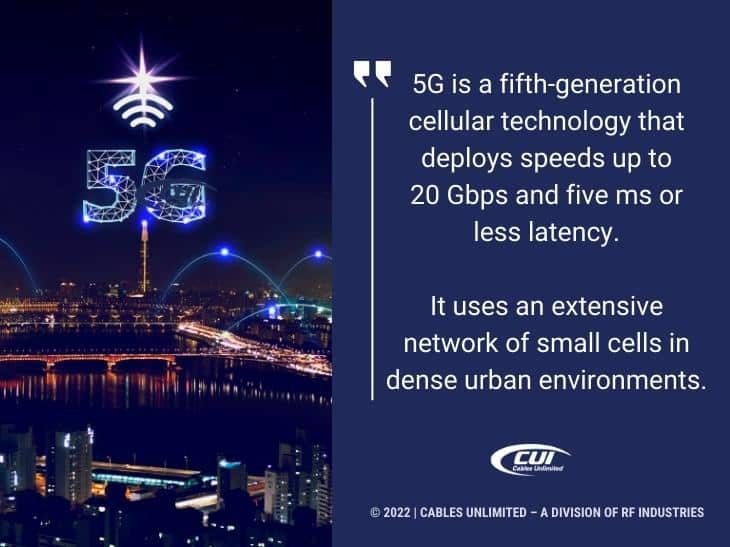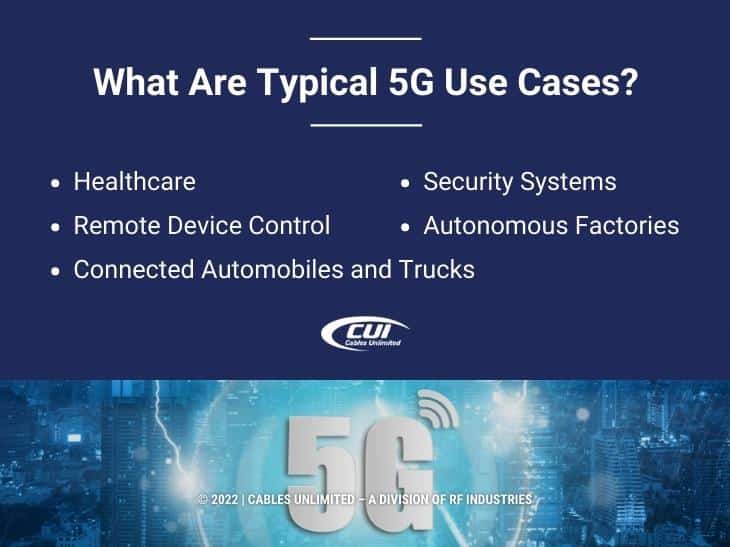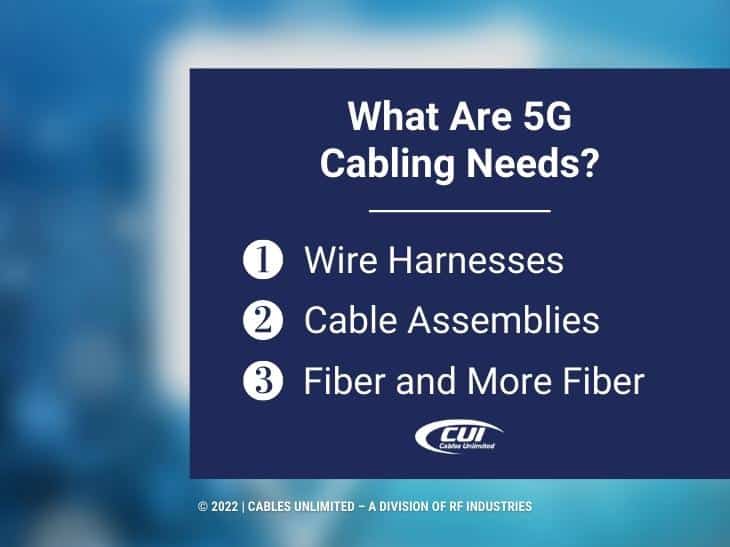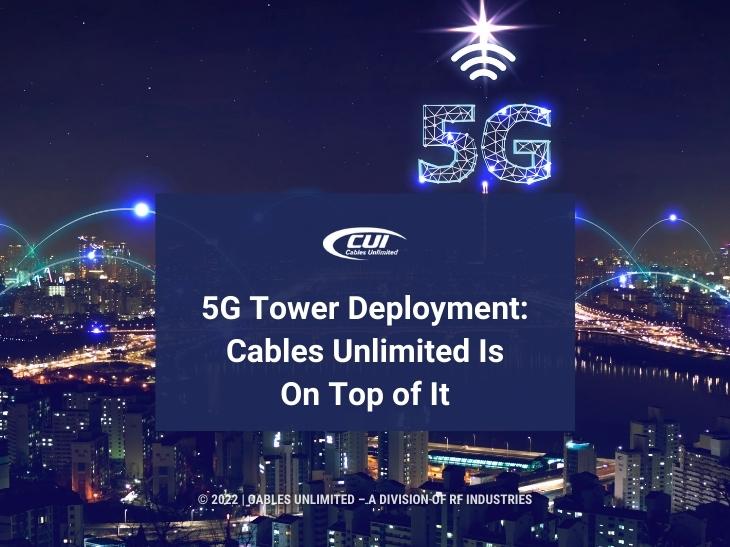At the beginning of 2022, there were an estimated 350,000 cell sites in the USA, of which 175,000 were 5G sites. That number is expected to grow exponentially, with 5G being added to all existing towers and deployment in dense urban environments from the top of buildings to power poles. With that growth comes a huge demand for equipment, antennas, and the cables that connect them. This article digs deeper into 5G deployment and how Cables Unlimited can help.
What Is 5G?
5G is fifth-generation cellular technology. It deploys speeds of up to 20 Gbps and five milliseconds or less latency. Second, it uses an extensive network of small cells on buildings, traffic lights, and similar structures in dense urban environments. Finally, while 4G typically has 200 to 400 users per cell, 5G is 100 times greater at 20,000 to 40,000 users per cell.

What Are Typical 5G Use Cases?
This is where 5G comes into its own. That high-speed, high-density coverage provides secure and highly reliable access that facilitates a wide range of applications. Here’s a short list.
- Healthcare. Reliable real-time access opens up the delivery of preventative care and even robotic surgery at a distance.
- Connected Automobiles and Trucks. Automated driving coupled with traffic management can relieve congestion and provide safer roads. Plus, long-haul trucking is currently limited due to necessary driver downtime. Autonomous trucks would reduce labor costs and allow freight to move day and night.
- Remote Device Control. The Internet of Things offers the potential to connect just about everything in homes and offices. 5G provides the speed and reliability to make it happen. It also offers the ability for drone control, thereby accelerating automated delivery options.
- Security Systems. Surveillance cameras open up a wide range of security applications, including building entry and law enforcement monitoring. But it takes the speed and bandwidth of 5G to make it happen.
- Autonomous Factories. With secure 5G communication systems, factories can eliminate wiring between machines, including robotic units, opening up further flexibility in rapidly reconfiguring the factory floor to respond to demand changes.
- Fixed Wireless Access. In remote areas worldwide, Internet access remains limited due to the high cost of cabling. 5G service opens the opportunity of providing access without wires and reaching far more people. Read more in our blog: Insight Into Fixed Wireless Access – Pros and Cons.

How Is 5G Deployed?
A typical 4G macro cell tower covers roughly 10 square miles. With 5G’s dense small cell structure, you can expect up to 60 small cells covering just one square mile. That’s a 1:600 ratio. On top of that dense structure are the far higher speed requirements for 5G, which necessitates using fiber optic cables. Fiber provides those increased speeds plus low attenuation, immunity to interference, and nearly unlimited bandwidth.
Then there is the sheer number of cables required to connect the 60 cells per square mile. Estimates are that 8 miles of fiber optic cabling would be needed for those connections. Plus, there are thousands of cables within each cell. That’s 600 times more than was required for a 4G macro cell tower.
Read more in our blog: The Role of Fiber Optic Cables in USA Cell Tower Infrastructure
What Are 5G Cabling Needs?
As you can tell from the numbers above, the demand for cables, including wire harnesses, cable assemblies, and fiber optics, has increased greatly over the current year. Then there’s the requirement for higher speeds and smaller sizes. On top of that are all the connectors required to bring everything together.
- Wire Harnesses. The demand for wire harnesses is expecting a 6% compound annual growth rate reaching $191 billion by 2030. Wire harnesses offer multiple cables and wires bundled within an insulating material. That means they can quickly be pretested and dropped into the overall assembly process.
- Cable Assemblies. The growth in cable assemblies is expected to be $68 billion from 2021 to 2025, with a compound growth rate of 7%. Cable assemblies offer similar advantages to wire harnesses but are defined as a group of wires or cables encased in a single tube of heavy-duty material. They are excellent in small cell networks.
- Fiber and More Fiber. Both wire harnesses and cable assemblies often include fiber optic cables. Plus, they are often deployed on their own in several 5G applications. They are essential for the high speeds and low latency required for 5G deployment.

We Can Help with Your 5G Deployment Cable Selection
We’ve got you covered for 5G cables. For example, our OptiFlex™ Hybrid Composite Cables are optimum for upgrading a wireless tower infrastructure to 5G technology.
If your requirements are already specified and ready for a quote for your current projects, we are prepared to meet your deadlines and pricing targets. Our extensive in-house services and advanced manufacturing capabilities are in place to meet your requirements.
But Cables Unlimited offers much more than state-of-the-art manufacturing – our dedicated team is also known for going to great lengths to meet the needs of our customers, including working round-the-clock to meet tight turnaround time requirements.
Our sales representatives are standing by to assist you with product questions and quotes Monday – Friday, 8:00 am to 5:00 pm Eastern. You can also send us an email or complete our contact form, and we’ll get right back to you.




